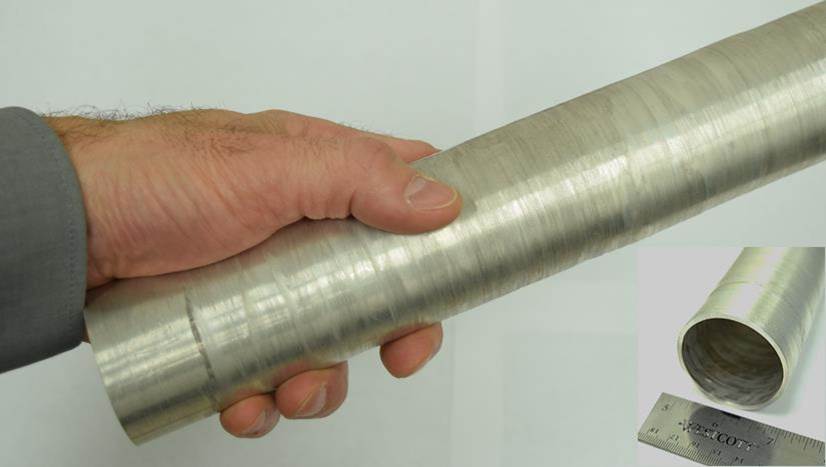
Magnesium is 75% lighter than steel and 33% lighter than aluminum. As the lightest of all structural metals, magnesium has a lot of potential for lightweighting cars and trucks in the aim of improving fuel economy. However, auto makers have been challenged in their attempts to incorporate magnesium alloys into structural car parts.
The Department of Energy’s (DOE’s) Pacific Northwest National Laboratory (PNNL) developed a new process that could make more feasible to use magnesium alloys in automotive structural components. The method is a version of the extrusion process (in which the metal is forced through a tool to create a certain shape) and has the potential to reduce cost by eliminating the need for rare-earth (RE) elements, while simultaneously improving the material’s structural properties.
Initial research presented in Materials Science and Engineering A [1] and Magnesium Technology [2] found that the PNNL-developed process greatly improves the energy absorption of magnesium by creating novel microstructures which are not possible with traditional extrusion methods. It also improves a property called ductility — which is how far the metal can be stretched before it breaks. These enhancements make magnesium easier to work with and more likely to be used in structural car parts. Currently, magnesium components account for only about 1 percent, or 33 pounds, of a typical car’s weight according to a DOE report.
“Today, many vehicle manufacturers do not use magnesium in structural locations because of the two Ps — price and properties,” said Scott Whalen, principal investigator and mechanical engineer at PNNL. “Right now, manufacturers opt for low-cost aluminum in components, such as bumper beams and crush tips. Using our process, we have enhanced the mechanical properties of magnesium to the point where it can now be considered instead of aluminum for these applications — without the added cost of rare-earth elements.”
A New Spin on Extrusion
Researchers theorized that spinning the magnesium alloy during the extrusion process would create just enough heat to soften the material so that it could be easily pressed through a die in order to create tubes, rods, and channels. Heat generated from mechanical friction deforming the metal, provides all of the heat necessary for the process, eliminating the need for energy-intensive resistance heaters used in traditional extrusion presses. The PNNL team designed and commissioned an industrial version of their idea and received a one-of-a-kind, custom built Shear Assisted Processing and Extrusion machine — coining the acronym for ShAPE™.
The billets or chunks of bulk magnesium alloys flow through the die in a very soft state, thanks to the simultaneous linear and rotational forces of the ShAPE™ machine. This means only one-tenth of the force is needed to push the material through a die compared to conventional extrusion. This significant reduction in force would enable substantially smaller production machinery, thus lowering capital expenditures and operations costs for adapting this patent-pending process for industry. The force is so low, that the amount of electricity used to make a 1 ft length of 2 inch diameter tubing is about the same as it takes to run a residential kitchen oven for just 60 seconds.
Energy is saved since the heat generated at the billet/die interface is the only process heat required to soften the magnesium. “We don’t need giant heaters surrounding the billets of magnesium like industrial extrusion machines,” said Whalen. “We are heating — with friction only — right at the place that matters.”
With the ShAPE process, the PNNL team successfully extruded very thin-walled round tubing, up to two inches in diameter, from magnesium-aluminum-zinc alloys AZ91 and ZK60A, improving their mechanical properties in the process. For example, room temperature ductility above 25% was independently measured — a large improvement compared to typical extrusions.
“In the ShAPE process, we get highly refined microstructures within the metal and, in some cases, are even able to form nanostructured features,” said Whalen. “The higher the rotations per minute, the smaller the grains become which makes the tubing stronger and more ductile or pliable. Additionally, we can control the orientation of the crystalline structures in the metal to improve the energy absorption of magnesium so it’s equal to that of aluminum.”
Further Development
Magna-Cosma, a global auto industry parts supplier, is teaming with PNNL on this DOE funded research project in order to advance low cost magnesium parts and, as larger tubes are developed, will be testing them at one of their production facilities near Detroit.
PNNL’s ShAPE™ technology is available for licensing.
References
- N. Overman, et al., “Homogenization and Texture Development in Rapidly Solidified AZ91E Consolidated by Shear Assisted Processing and Extrusion (ShAPE),” Materials Science and Engineering A, June 12, 2017, pp. 56-68, DOI: 10.1016/j.msea.2017.06.062.
- S. Whalen, et al., “Scaled-Up Fabrication of Thin-Walled Magnesium ZK60 Tubing using Shear Assisted Processing and Extrusion (ShAPE),” Magnesium Technology, Feb 16, 2017, pp. 315-321, DOI: 10.1007/978-3-319-52392-7_45.
